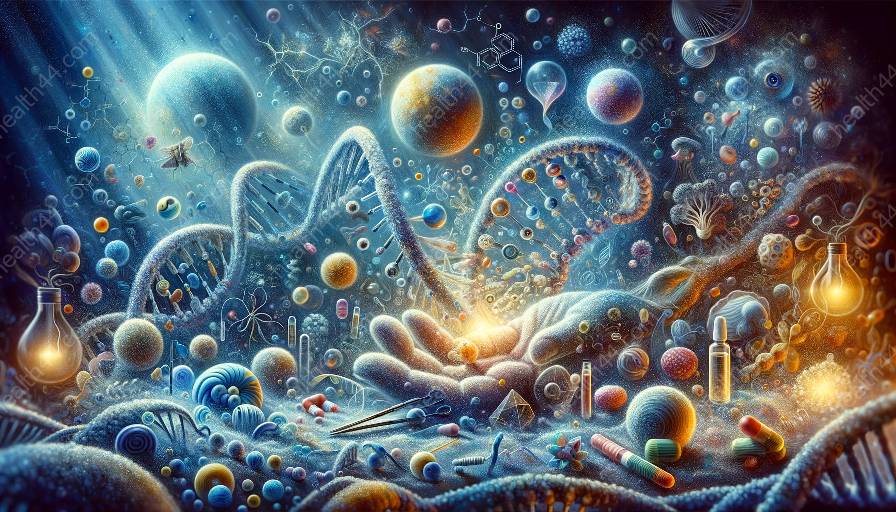Gene regulation in response to environmental stimuli is a fascinating field that delves into the intricate mechanisms governing the expression and suppression of genes in response to various environmental cues. This topic is at the intersection of functional genomics and genetics, providing valuable insights into how an organism's genetic makeup interacts with its environment to dictate gene expression patterns.
Understanding Gene Regulation
Gene regulation refers to the myriad of processes that cells employ to control the expression of genes, ensuring that the right genes are activated or repressed at the appropriate times. It is a highly dynamic and complex process that involves multiple layers of control, allowing an organism to adapt to its ever-changing environment.
Environmental Stimuli and Gene Expression
Environmental stimuli, such as temperature changes, exposure to toxins, or nutritional fluctuations, can have a profound impact on gene expression. These stimuli can trigger intricate signaling cascades within the cells, leading to the activation of specific genes while concurrently suppressing others. This allows organisms to mount tailored responses to cope with environmental challenges.
Functional Genomics: Unraveling Gene Function
Functional genomics plays a crucial role in dissecting the intricate web of gene regulation in response to environmental stimuli. It encompasses the systematic study of gene function on a global scale, aiming to understand how genes interact with each other and with the environment. By integrating high-throughput technologies, such as next-generation sequencing and genome-wide association studies, functional genomics provides a comprehensive view of gene regulation dynamics.
Genetic Basis of Environmental Responses
Genetics provides the foundational framework for understanding how organisms respond to environmental stimuli at the molecular level. The interplay between an organism's genetic makeup and its response to environmental cues is a central theme in genetics. Through the study of genetic variation and heritability, genetics unravels the genetic underpinnings of environmental responses, shedding light on the diversity of gene regulation patterns among different individuals and species.
Mechanisms of Gene Regulation
The mechanisms governing gene regulation in response to environmental stimuli are multifaceted and involve various levels of control, including epigenetic modifications, transcriptional regulation, post-transcriptional modifications, and protein interactions. These mechanisms orchestrate a highly coordinated system that ensures the precise regulation of gene expression in response to environmental cues.
Epigenetic Modifications
Epigenetic modifications, such as DNA methylation and histone acetylation, play a pivotal role in gene regulation. Environmental stimuli can influence the epigenetic landscape of an organism, leading to alterations in gene expression patterns. Understanding the interplay between environmental cues and epigenetic modifications provides valuable insights into how organisms adapt to changing environments.
Transcriptional Regulation
Transcriptional regulation involves the control of RNA synthesis from DNA, dictating when and to what extent a gene is transcribed. Environmental stimuli can activate transcription factors, which bind to specific DNA sequences and modulate gene expression. This dynamic process allows for rapid changes in gene expression in response to environmental challenges.
Post-Transcriptional Modifications
Post-transcriptional modifications, including alternative splicing and RNA editing, contribute to the diversity of gene regulation patterns. Environmental stimuli can impact these processes, leading to the generation of functionally distinct RNA isoforms that modulate the cellular response to environmental changes.
Protein Interactions and Signaling Pathways
Proteins are the ultimate effectors of gene regulation, and their interactions and signaling pathways are intricately linked to environmental stimuli. Cell signaling cascades activated by environmental cues can propagate signals to the nucleus, modulating the expression of specific genes. Understanding the crosstalk between proteins and environmental stimuli provides a holistic view of gene regulation dynamics.
Applications in Disease and Evolution
The insights gleaned from studying gene regulation in response to environmental stimuli have far-reaching implications in disease and evolution. Understanding how genetic and environmental factors intersect to regulate gene expression lays the foundation for unraveling the molecular basis of complex diseases and deciphering the mechanisms underlying evolutionary adaptations.
Disease Susceptibility and Environmental Triggers
The interplay between genetic predisposition and environmental triggers can influence an individual's susceptibility to diseases. By deciphering the gene regulation patterns in response to environmental stimuli, researchers can gain a deeper understanding of the molecular mechanisms underlying disease susceptibility, paving the way for personalized medicine and targeted interventions.
Evolutionary Adaptations
Gene regulation in response to environmental stimuli shapes the diversity of traits observed in different species, driving evolutionary adaptations. By unraveling the genetic and environmental determinants of gene expression, scientists can elucidate the molecular mechanisms that underlie evolutionary changes, shedding light on the intricate interplay between genes and the environment in shaping the trajectory of evolution.
Conclusion
Gene regulation in response to environmental stimuli is a captivating and multifaceted field that integrates functional genomics and genetics to unravel the intricate mechanisms governing gene expression in dynamic environments. By deciphering the crosstalk between genetic and environmental factors, researchers can unlock the secrets of how organisms adapt and thrive in their ever-changing surroundings, with profound implications for disease, evolution, and personalized medicine.


